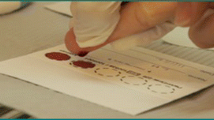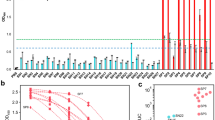Abstract
A highly purified and bioactive immunoglobulin G monoclonal antibody against receptor-binding domain of SARS-CoV-2 (RBD-IgG-MAb) has been accurately quantified by amino acid determination using isotope dilution liquid chromatography–mass spectrometry. Absolute quantification of RBD-IgG-MAb was achieved by averaging 4 amino acid certified reference materials, which allows the quantitative value (66.1 ± 5.8 μg/L) to be traced to SI unit (mol). Afterwards, the RBD-IgG-MAb was employed as control and calibration compound for the development of a point-of-care testing (POCT) system based on colloidal gold lateral flow immunoassay, which aimed to rapidly and accurately detect the level of protective RBD-IgG after vaccination. Under the detection parameters, a sigmoidal curve has been plotted between signal intensity and the logarithmic concentration for quantitative detection with the limit of detection of about 0.39 μg/mL. The relative standard deviations of intra-assay and inter-assay were lower than 2.3% and 14%, and the recoveries ranged from 87 to 100%, respectively. Fingertip blood samples from 37 volunteers after vaccination were analyzed by the POCT system; results showed that levels of RBD-IgG in 33 out of 37 samples ranged from 0.45 to 2.46 μg/mL with the average level of 0.91 μg/mL. The developed POCT system has been successfully established with the quantity-traceability RBD-IgG-MAb as control and calibration compound, and the scientific contribution of this work can be promoted to other areas.
Graphical Abstract






Similar content being viewed by others
Data Availability
The data that support the findings of this study are available from the corresponding author upon reasonable request.
References
Muruato AE, Fontes-Garfias CR, Ren P, Garcia-Blanco MA, Menachery VD, Xie X, Shi PY (2020) A high-throughput neutralizing antibody assay for COVID-19 diagnosis and vaccine evaluation. Nat Commun 11(1):4059. https://doi.org/10.1038/s41467-020-17892-0
Chen L, Xiong J, Bao L, Shi Y (2020) Convalescent plasma as a potential therapy for COVID-19. Lancet Infect Dis 20(4):398–400. https://doi.org/10.1016/S1473-3099(20)30141-9
Cao X (2020) COVID-19: immunopathology and its implications for therapy. Nat Rev Immunol 20(5):269–270. https://doi.org/10.1038/s41577-020-0308-3
Ge XY, Li JL, Yang XL, Chmura AA, Zhu G, Epstein JH, Shi ZL (2013) Isolation and characterization of a bat SARS-like coronavirus that uses the ACE2 receptor. Nature 503(7477):535–538. https://doi.org/10.1038/nature12711
Yan R, Zhang Y, Li Y, Xia L, Guo Y, Zhou Q (2020) Structural basis for the recognition of SARS-CoV-2 by full-length human ACE2. Science 367(6485):1444–1448. https://doi.org/10.1126/science.abb2762
Walls AC, Park YJ, Tortorici MA, Wall A, McGuire AT, Veesler D (2020) Structure, function, and antigenicity of the SARS-CoV-2 spike glycoprotein. Cell 181(2):281–292. https://doi.org/10.1016/j.cell.2020.02.058
Bertoglio F, Fühner V, Ruschig M et al (2021) A SARS-CoV-2 neutralizing antibody selected from COVID-19 patients binds to the ACE2-RBD interface and is tolerant to most known RBD mutations. Cell Rep 36(4). https://doi.org/10.1016/j.celrep.2021.109433
Hoffmann M, Kleine-Weber H, Schroeder S et al (2020) SARS-CoV-2 cell entry depends on ACE2 and TMPRSS2 and is blocked by a clinically proven protease inhibitor. Cell 181(2):271–280. https://doi.org/10.1016/j.cell.2020.02.052
Thomas SJ, Nisalak A, Anderson KB et al (2009) Dengue plaque reduction neutralization test (PRNT) in primary and secondary dengue virus infections: how alterations in assay conditions impact performance. Am J Trop Med Hyg 81(5):825. https://doi.org/10.4269/ajtmh.2009.08-0625
Krammer F (2020) SARS-CoV-2 vaccines in development. Nature 586(7830):516–527. https://doi.org/10.1038/s41586-020-2798-3
Duan X, Shi Y, Zhang X et al (2022) Dual-detection fluorescent immunochromatographic assay for quantitative detection of SARS-CoV-2 spike RBD-ACE2 blocking neutralizing antibody[J]. Biosens Bioelectron 199:113883. https://doi.org/10.1016/j.bios.2021.113883
Huang L, Li Y, Luo C et al (2022) Novel nanostructure-coupled biosensor platform for one-step high-throughput quantification of serum neutralizing antibody after COVID-19 vaccination. Biosens Bioelectron 199:113868. https://doi.org/10.1016/j.bios.2021.113868
Wang JJ, Zhang N, Richardson SA et al (2021) Rapid lateral flow tests for the detection of SARS-CoV-2 neutralizing antibodies[J]. Expert Rev Mol Diagn 21(4):363–370. https://doi.org/10.1080/14737159.2021.1913123
Liu B, Wu Z, Liang C et al (2021) Development of a smartphone-based nanozyme-linked immunosorbent assay for quantitative detection of SARS-CoV-2 nucleocapsid phosphoprotein in blood. Front Microbiol 12:692831. https://doi.org/10.3389/fmicb.2021.692831
Kubo S, Ohtake N, Miyakawa K et al (2021) Development of an automated chemiluminescence assay system for quantitative measurement of multiple anti-SARS-CoV-2 antibodies. Front Microbiol 11:628281. https://doi.org/10.3389/fmicb.2020.628281
Jiang M, Dong T, Han C et al (2022) Regenerable and high-throughput surface plasmon resonance assay for rapid screening of anti-SARS-CoV-2 antibody in serum samples. Anal Chim Acta 1208:339830. https://doi.org/10.1016/j.aca.2022.339830
Chen S, Meng L, Wang L et al (2021) SERS-based lateral flow immunoassay for sensitive and simultaneous detection of anti-SARS-CoV-2 IgM and IgG antibodies by using gap-enhanced Raman nanotags. Sens Actuators B Chem 348:130706. https://doi.org/10.1016/j.snb.2021.130706
Wang C, Wu Z, Liu B et al (2021) Track-etched membrane microplate and smartphone immunosensing for SARS-CoV-2 neutralizing antibody. Biosens Bioelectron 192:113550. https://doi.org/10.1016/j.bios.2021.113550
Xiao W, Huang C, Xu F et al (2018) A simple and compact smartphone-based device for the quantitative readout of colloidal gold lateral flow immunoassay strips. Sens Actuators B Chem 266:63–70. https://doi.org/10.1016/j.snb.2018.03.110
Peng T, Sui Z, Huang Z et al (2021) Point-of-care test system for detection of immunoglobulin-G and-M against nucleocapsid protein and spike glycoprotein of SARS-CoV-2. Sens Actuators B Chem 331:129415. https://doi.org/10.1016/j.snb.2020.129415
Liu J, Zhu W, Sun H et al (2021) Development of a primary reference material of natural C-reactive protein: verification of its natural pentameric structure and certification by two isotope dilution mass spectrometry. Anal Methods 13(5):626–635. https://doi.org/10.1039/D0AY02289F
Jeong JS, Lim HM, Kim SK et al (2011) Quantification of human growth hormone by amino acid composition analysis using isotope dilution liquid-chromatography tandem mass spectrometry. J Chromatogr A 1218(38):6596–6602. https://doi.org/10.1016/j.chroma.2011.07.053
Yim JH, Yoon I, Yang HJ et al (2014) Quantification of recombinant human erythropoietin by amino acid analysis using isotope dilution liquid chromatography–tandem mass spectrometry. Anal Bioanal Chem 406:4401–4409. https://doi.org/10.1007/s00216-014-7838-0
Pierce-Ruiz C, Santana WI, Sutton WJH et al (2021) Quantification of SARS-CoV-2 spike and nucleocapsid proteins using isotope dilution tandem mass spectrometry. Vaccine 39(36):5106–5115. https://doi.org/10.1016/j.vaccine.2021.07.066
Cazares LH, Ward MD, Brueggemann EE et al (2016) Development of a liquid chromatography high resolution mass spectrometry method for the quantitation of viral envelope glycoprotein in Ebola virus-like particle vaccine preparations. Clin Proteomics 13(1):1–18. https://doi.org/10.1186/s12014-016-9119-8
Whiting G, Vipond C, Facchetti A et al (2020) Measurement of surface protein antigens, PorA and PorB, in Bexsero vaccine using quantitative mass spectrometry. Vaccine 38(6):1431–1435. https://doi.org/10.1016/j.vaccine.2019.11.082
Williams TL, Luna L, Guo Z et al (2008) Quantification of influenza virus hemagglutinins in complex mixtures using isotope dilution tandem mass spectrometry. Vaccine 26(20):2510–2520. https://doi.org/10.1016/j.vaccine.2008.03.014
Santana WI, Williams TL, Winne EK et al (2014) Quantification of viral proteins of the avian H7 subtype of influenza virus: an isotope dilution mass spectrometry method applicable for producing more rapid vaccines in the case of an influenza pandemic. Anal Chem 86(9):4088–4095. https://doi.org/10.1021/ac4040778
Peng T, Jiao X, Liang Z et al (2021) Lateral flow immunoassay coupled with copper enhancement for rapid and sensitive SARS-CoV-2 nucleocapsid protein detection. Biosensors 12(1):13. https://doi.org/10.3390/bios12010013
Munoz A, Kral R, Schimmel H (2011) Quantification of protein calibrants by amino acid analysis using isotope dilution mass spectrometry. Anal Biochem 408(1):124–131. https://doi.org/10.1016/j.ab.2010.08.037
Li C, Luo W, Xu H et al (2013) Development of an immunochromatographic assay for rapid and quantitative detection of clenbuterol in swine urine. Food Control 34(2):725–732. https://doi.org/10.1016/j.foodcont.2013.06.021
Padoan A, Cosma C, Bonfante F et al (2022) Neutralizing antibody titers six months after Comirnaty vaccination: kinetics and comparison with SARS-CoV-2 immunoassays. Clin Chem Lab Med 60(3):456–463. https://doi.org/10.1515/cclm-2021-1247
Israel A, Shenhar Y, Green I et al (2021) Large-scale study of antibody titer decay following BNT162b2 mRNA vaccine or SARS-CoV-2 infection. Vaccines 10(1):64. https://doi.org/10.1101/2021.08.19.21262111
Acknowledgements
We thank Suzhou Novoprotein Technology Co. Ltd. for their provision of RBD-IgG-MAb raw materials. And the authors appreciate the support of colleagues in the Center for Advanced Measurement of Science, NIM.
Funding
This work was financially supported by the National Key Research and Development program of China (No. 2022YFF0608402) and Fundamental Research Funds for Central Public Welfare Scientific Research Institutes sponsored by National Institute of Metrology, P.R. China (No. AKYYJ2111-2).
Author information
Authors and Affiliations
Contributions
Zhanwei Liang and Xin Lu: investigation, validation, visualization, data curation, writing — original draft preparation. Xueshima Jiao: investigation, validation, data curation. Yi He: validation, formal analysis. Bo Meng: investigation, data curation. Jie Xie: validation, formal analysis. Ziyu Qu: resources. Manman Zhu: validation, resources. Xiaoyun Gong: resources, formal analysis. Yang Zhao: formal analysis. You Jiang: resources, formal analysis. Tao Peng: methodology, formal analysis, data curation, writing — original draft preparation, writing — reviewing and editing, funding acquisition. Xinhua Dai: methodology, supervision, writing — reviewing and editing. Xiang Fang: project administration, supervision, conceptualization.
Corresponding authors
Ethics declarations
Competing interests
The authors declare no competing interests.
Additional information
Publisher's Note
Springer Nature remains neutral with regard to jurisdictional claims in published maps and institutional affiliations.
Supplementary Information
Below is the link to the electronic supplementary material.
Rights and permissions
Springer Nature or its licensor (e.g. a society or other partner) holds exclusive rights to this article under a publishing agreement with the author(s) or other rightsholder(s); author self-archiving of the accepted manuscript version of this article is solely governed by the terms of such publishing agreement and applicable law.
About this article
Cite this article
Liang, Z., Lu, X., Jiao, X. et al. Traceable value of immunoglobulin G against receptor-binding domain of SARS-CoV-2 confirmation and application to point-of-care testing system development. Microchim Acta 190, 417 (2023). https://doi.org/10.1007/s00604-023-06004-6
Received:
Accepted:
Published:
DOI: https://doi.org/10.1007/s00604-023-06004-6




